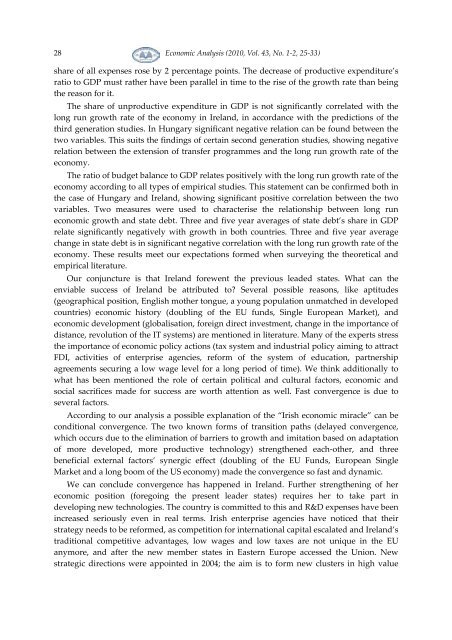Twice a Year Scientific Journal
Twice a Year Scientific Journal
Twice a Year Scientific Journal
Create successful ePaper yourself
Turn your PDF publications into a flip-book with our unique Google optimized e-Paper software.
28<br />
Economic Analysis (2010, Vol. 43, No. 1-2, 25-33)<br />
share of all expenses rose by 2 percentage points. The decrease of productive expenditure’s<br />
ratio to GDP must rather have been parallel in time to the rise of the growth rate than being<br />
the reason for it.<br />
The share of unproductive expenditure in GDP is not significantly correlated with the<br />
long run growth rate of the economy in Ireland, in accordance with the predictions of the<br />
third generation studies. In Hungary significant negative relation can be found between the<br />
two variables. This suits the findings of certain second generation studies, showing negative<br />
relation between the extension of transfer programmes and the long run growth rate of the<br />
economy.<br />
The ratio of budget balance to GDP relates positively with the long run growth rate of the<br />
economy according to all types of empirical studies. This statement can be confirmed both in<br />
the case of Hungary and Ireland, showing significant positive correlation between the two<br />
variables. Two measures were used to characterise the relationship between long run<br />
economic growth and state debt. Three and five year averages of state debt’s share in GDP<br />
relate significantly negatively with growth in both countries. Three and five year average<br />
change in state debt is in significant negative correlation with the long run growth rate of the<br />
economy. These results meet our expectations formed when surveying the theoretical and<br />
empirical literature.<br />
Our conjuncture is that Ireland forewent the previous leaded states. What can the<br />
enviable success of Ireland be attributed to? Several possible reasons, like aptitudes<br />
(geographical position, English mother tongue, a young population unmatched in developed<br />
countries) economic history (doubling of the EU funds, Single European Market), and<br />
economic development (globalisation, foreign direct investment, change in the importance of<br />
distance, revolution of the IT systems) are mentioned in literature. Many of the experts stress<br />
the importance of economic policy actions (tax system and industrial policy aiming to attract<br />
FDI, activities of enterprise agencies, reform of the system of education, partnership<br />
agreements securing a low wage level for a long period of time). We think additionally to<br />
what has been mentioned the role of certain political and cultural factors, economic and<br />
social sacrifices made for success are worth attention as well. Fast convergence is due to<br />
several factors.<br />
According to our analysis a possible explanation of the “Irish economic miracle” can be<br />
conditional convergence. The two known forms of transition paths (delayed convergence,<br />
which occurs due to the elimination of barriers to growth and imitation based on adaptation<br />
of more developed, more productive technology) strengthened each-other, and three<br />
beneficial external factors’ synergic effect (doubling of the EU Funds, European Single<br />
Market and a long boom of the US economy) made the convergence so fast and dynamic.<br />
We can conclude convergence has happened in Ireland. Further strengthening of her<br />
economic position (foregoing the present leader states) requires her to take part in<br />
developing new technologies. The country is committed to this and R&D expenses have been<br />
increased seriously even in real terms. Irish enterprise agencies have noticed that their<br />
strategy needs to be reformed, as competition for international capital escalated and Ireland’s<br />
traditional competitive advantages, low wages and low taxes are not unique in the EU<br />
anymore, and after the new member states in Eastern Europe accessed the Union. New<br />
strategic directions were appointed in 2004; the aim is to form new clusters in high value
















